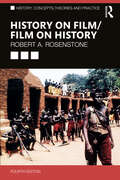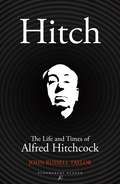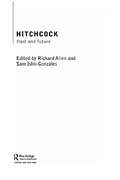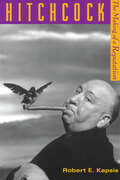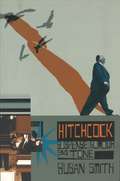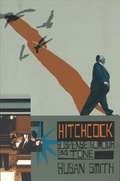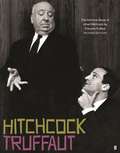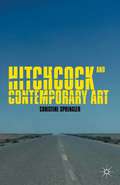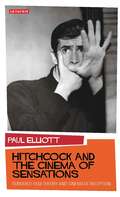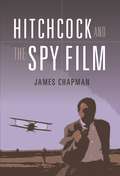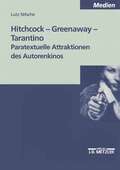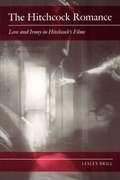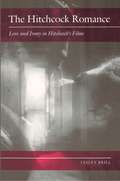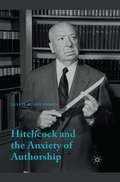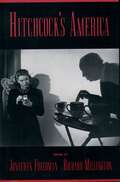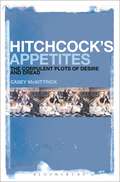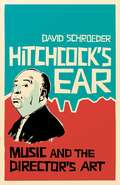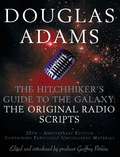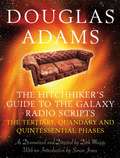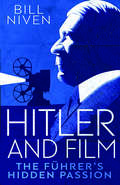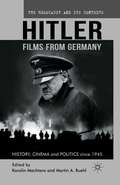- Table View
- List View
History on Film/Film on History (History: Concepts,Theories and Practice)
by Robert A. RosenstoneHistory on Film/Film on History has established itself as a classic treatise on the historical film and its role in bringing the past to life. In the fourth edition of this widely acclaimed text, Robert A. Rosenstone argues that to leave history films out of the discussion of the meaning of the past is to ignore a major means of understanding historical events. This book examines what history films convey about the past and how they convey it, demonstrating the need to learn how to read and understand this new visual world and integrating detailed analysis of films such as Schindler’s List, Glory, October, and Reds. Advocating for the dramatic feature as a legitimate way of doing history, this edition includes a new Preface and a new chapter that focuses on films produced in Latin America, Africa, the Middle East, India, and East Asia. Examining the codes and conventions of how these films tell us about the past and providing guidance on how to effectively analyse films as historical interpretations, this book is an essential introduction to the field for students of history and film.
Hitch: The Life and Times of Alfred Hitchcock
by John Russell TaylorOne of cinema's greatest directors, a virtuoso visual artist, and a genius of the suspense genre, Alfred Hitchcock (1899–1980) is universally known for such masterpieces as Strangers on a Train, Rear Window, Vertigo, North by Northwest, Psycho, and The Birds. John Russell Taylor, a distinguished film critic and friend of Hitchcock's, enjoyed his full cooperation. Based on numerous interviews, with photos from the private family albums, and an in-depth study of the making of his last film, this biography of the director is as intriguing, revealing, perverse, and entertaining as any Hitchcock classic.
Hitchcock: Past and Future
by Richard Allen Sam Ishii-GonzalesThis new collection of writings on Alfred Hitchcock considers Hitchcock both in his time and as a continuing influence on filmmakers, films and film theory. The contributions, who include leading scholars such as Slavoj Zizek, Laura Mulvey, Peter Wollen, and James Naremore, discuss canonical films such as Notorious and The Birds alongside lesser-known works including Juno and the Paycock and Frenzy. Articles are grouped into four thematic sections: 'Authorship and Aesthetics' examines Hitchcock as auteur and investigates central topics in Hitchcockian aesthetics. 'French Hitchcock' looks at Hitchcock's influence on filmmakers such as Chabrol, Truffaut and Rohmer, and how film critics such as Bazin and Deleuze have engaged with Hitchcock's work. 'Poetics and Politics of Identity' explores the representation of personal and political in Hitchcock's work. The final section, 'Death and Transfiguration' addresses the manner in which the spectacle and figuration of death haunts the narrative universe of Hitchcock's films, in particular his subversive masterpiece Psycho.
Hitchcock: Past and Future
by Richard Allen Sam Ishii-GonzálesThis new collection of writings on Alfred Hitchcock considers Hitchcock both in his time and as a continuing influence on filmmakers, films and film theory. The contributions, who include leading scholars such as Slavoj Zizek, Laura Mulvey, Peter Wollen, and James Naremore, discuss canonical films such as Notorious and The Birds alongside lesser-known works including Juno and the Paycock and Frenzy. Articles are grouped into four thematic sections: 'Authorship and Aesthetics' examines Hitchcock as auteur and investigates central topics in Hitchcockian aesthetics. 'French Hitchcock' looks at Hitchcock's influence on filmmakers such as Chabrol, Truffaut and Rohmer, and how film critics such as Bazin and Deleuze have engaged with Hitchcock's work. 'Poetics and Politics of Identity' explores the representation of personal and political in Hitchcock's work. The final section, 'Death and Transfiguration' addresses the manner in which the spectacle and figuration of death haunts the narrative universe of Hitchcock's films, in particular his subversive masterpiece Psycho.
Hitchcock: The Making of a Reputation
by Robert E. KapsisFrom the beginning of his career, Alfred Hitchcock wanted to be considered an artist. Although his thrillers were immensely popular, and Hitchcock himself courted reviewers, he was, for many years, regarded as no more than a master craftsman. By the 1960s, though, critics began calling him an artist of unique vision and gifts. What happened to make Hitchcock's reputation as a true innovator and singular talent? Through a close examination of Hitchcock's personal papers, scripts, production notes, publicity files, correspondence, and hundreds of British and American reviews, Robert Kapsis here traces Hitchcock's changing critical fortunes. Vertigo, for instance, was considered a flawed film when first released; today it is viewed by many as the signal achievement of a great director. According to Kapsis, this dramatic change occurred because the making of the Hitchcock legend was not solely dependent on the quality of his films. Rather, his elevation to artist was caused by a successful blending of self-promotion, sponsorship by prominent members of the film community, and, most important, changes in critical theory which for the first time allowed for the idea of director as auteur. Kapsis also examines the careers of several other filmmakers who, like Hitchcock, have managed to cross the line that separates craftsman from artist, and shows how Hitchcock's legacy and reputation shed light on the way contemporary reputations are made. In a chapter about Brian De Palma, the most reknowned thriller director since Hitchcock, Kapsis explores how Hitchcock's legacy has affected contemporary work in—and criticism of—the thriller genre. Filled with fascinating anecdotes and intriguing excerpts, and augmented by interviews with Hitchcock's associates, this thoroughly documented and engagingly written book will appeal to scholars and film enthusiasts alike. "Required reading for Hitchcock scholars...scrupulously researched, invaluable material for those who continue to ask: what made the master tick?"—Anthony Perkins
Hitchcock: Suspense, Humour and Tone
by Susan SmithSusan Smith's treatment of the works of the most subtle of all film-makers analyses the key elements of suspense, humour and tone across the whole of the director's career. Arguing that all three are central to our viewing experience, the book demonstrates how Hitchcock's masterly integration of those elements is the key to his success as a film-maker.Examining in detail such films as Sabotage, Notorious, Rear Window, Psycho, Shadow of a Doubt, Rope and The Birds, amongst many others, the book discusses the idea of the director as saboteur and the importance of 'the avoidance of cliché' in Hitchcock's narrative.
Hitchcock: Suspense, Humour and Tone
by Susan SmithSusan Smith's treatment of the works of the most subtle of all film-makers analyses the key elements of suspense, humour and tone across the whole of the director's career. Arguing that all three are central to our viewing experience, the book demonstrates how Hitchcock's masterly integration of those elements is the key to his success as a film-maker.Examining in detail such films as Sabotage, Notorious, Rear Window, Psycho, Shadow of a Doubt, Rope and The Birds, amongst many others, the book discusses the idea of the director as saboteur and the importance of 'the avoidance of cliché' in Hitchcock's narrative.
Hitchcock
by Francois TruffautBased on the famous series of dialogues between Francois Truffaut and Alfred Hitchcock from the 1960s, the book moves chronologically through Hitchcock's films to discuss his career, techniques, and effects he achieved. It changed the way Hitchcock was perceived, as a popular director of suspense films - such as Psycho and The Birds - and revealed to moviegoers and critics, the depth of Hitchcock's perception and his mastery of the art form.As a result of the changed perceptions about Hitchcock, his masterpiece, Vertigo, hit the No 1 slot in Sight & Sound's recent poll of film-makers and critics, displacing Citizen Kane as the Best Film of all time.
Hitchcock and Contemporary Art
by C. SprenglerHitchcock and Contemporary Art introduces readers to the fascinating and diverse range of artistic practices devoted to Alfred Hitchcock's films. His works have the capacity to activate sophisticated engagements with Hitchcock's films and cinema more generally, tackling issues of time and space, memory and history, and sound and image.
Hitchcock and the Cinema of Sensations: Embodied Film Theory and Cinematic Reception (International Library of Visual Culture)
by Paul ElliottWhat happens to us when we 'see' a film? For the experience of what we see on screen draws as much upon the non-visual senses as it does on sight. In the first full-length analysis of the concept of embodied film theory, Paul Elliott charts the development of a 'cinema of sensations' - examining how cinema audiences use their corporeal selves and sensual memory to quite literally flesh out what they see on screen.Through the prism of Alfred Hitchcock's films, Elliott reveals how the body's sensations have a vital place in cinematic reception and the study of film: demonstrated here through the trope of nausea in Frenzy, pollution and smell in Shadow of a Doubt, physical sound reception in the Psycho shower scene and the importance of corporeality and closeness in Rear Window. He traces the way in which conceptual tools such as haptic vision, synaesthesia, physical sound reception and the aesthesiological body have been employed by film theorists and philosophers to better understand the processes inherent in the cinematic experience. He argues that the trend towards a sensually-based theoretical framework for film is indicative of a wider trend in visual thinking that is, in turn, linked to epistemological shifts and transformations in the way we situate ourselves in the world.Hitchcock and the Cinema of Sensations rethinks the body in the ci nema seat, seeing it not as a fleshy, insentient shell for the mind and eye but a feeling, thinking, evanescent site of sensation, memory and knowledge. The book provides a thoroughly new take on Hitchcock's classic films in order to demonstrate how taste, smell, hearing and touch can provide us with a corporeal level of understanding that sometimes compliments, sometimes clashes, with our more cognitive capabilities in the reception of film. This is essential reading for scholars and students of film studies, cultural theory and philosophy.
Hitchcock and the Spy Film
by James ChapmanFilm historian James Chapman has mined Hitchcock's own papers to investigate fully for the first time the spy thrillers of the world's most famous filmmaker. Hitchcock made his name as director of the spy movie. He returned repeatedly to the genre from the British classics of the 1930s, including The 39 Steps and The Lady Vanishes, through wartime Hollywood films Foreign Correspondent and Saboteur to the Cold War tracts North by Northwest, Torn Curtain and his unmade film The Short Night. Chapman's close reading of these films demonstrates the development of Hitchcock's own style as well as how the spy genre as a whole responded to changing political and cultural contexts from the threat of Nazism in the 1930s and 40s to the atom spies and double agents of the post-war world
Hitchcock - Greenaway - Tarantino: Paratextuelle Attraktionen des Autorenkinos
by Lutz NitscheDer wichtigste "special effect" des Autorenkinos ist das Image seiner Regisseure. Filme werden vom Publikum leidenschaftlicher gesehen, in der Öffentlichkeit intensiver kritisiert, wenn neben der Leinwand die Imagination einer Künstlerpersönlichkeit aufscheint. Die Studie beschreibt die Verflechtung von filmischem Oeuvre und jenen Randzonen, die Gérard Genette als Paratexte bezeichnet: Interview, Werbeanzeigen und die filmische Selbstdarstellung. Mit welcher Rhetorik evozieren diese Paratexte das Charisma des Star-Regisseurs? Welchen Anspruch auf Autorschaft formulieren sie? Am Beispiel von drei Regisseuren wird eine paratextuelle Pragmatik des Autorenkinos entwickelt. Der hier vorgestellte Blick fällt seitlich auf das Werk. Und es zeigt sich, dass dort Autoren zu entdecken sind - jenseits der Leinwand.
The Hitchcock Romance: Love and Irony in Hitchcock's Films
by Lesley BrillWas Alfred Hitchcock a cynical trifler with his audience's emotions, as he liked to pretend? Or was he a profoundly humane artist? Most commentators leave Hitchcock's self-assessment unquestioned, but this book shows that his movies convey an affectionate, hopeful understanding of human nature and the redemptive possibilities of love. Lesley Brill discusses Hitchcock's work as a whole and examines in detail twenty-two films, from perennial favorites like North by Northwest to neglected masterpieces like Rich and Strange.
The Hitchcock Romance: Love and Irony in Hitchcock's Films
by Lesley BrillWas Alfred Hitchcock a cynical trifler with his audience's emotions, as he liked to pretend? Or was he a profoundly humane artist? Most commentators leave Hitchcock's self-assessment unquestioned, but this book shows that his movies convey an affectionate, hopeful understanding of human nature and the redemptive possibilities of love. Lesley Brill discusses Hitchcock's work as a whole and examines in detail twenty-two films, from perennial favorites like North by Northwest to neglected masterpieces like Rich and Strange.
The Hitchcock Romance: Love and Irony in Hitchcock's Films
by Lesley BrillWas Alfred Hitchcock a cynical trifler with his audience's emotions, as he liked to pretend? Or was he a profoundly humane artist? Most commentators leave Hitchcock's self-assessment unquestioned, but this book shows that his movies convey an affectionate, hopeful understanding of human nature and the redemptive possibilities of love. Lesley Brill discusses Hitchcock's work as a whole and examines in detail twenty-two films, from perennial favorites like North by Northwest to neglected masterpieces like Rich and Strange.
Hitchcock & the Anxiety of Authorship
by Leslie H. AbramsonHitchcock and the Anxiety of Authorship examines issues of cinema authorship engaged by and dynamized within the director's films. A unique study of self-reflexivity in Hitchcock's work from his earliest English silents to his final Hollywood features, this book considers how the director's releases constitute ever-shifting meditations on the conditions and struggles of creative agency in cinema. Abramson explores how, located in literal and emblematic sites of dramatic production, exhibition, and reception, and populated by figures of directors, actors, and audiences, Hitchcock's films exhibit a complicated, often disturbing vision of authorship - one that consistently problematizes rather than exemplifies the director's longstanding auteurist image. Viewing Hitchcock in a striking new light, Abramson analyzes these allegories of vexed agency in the context of his concepts of and commentary on the troubled association between cinema artistry and authorship, as well as the changing cultural, industrial, theoretical, and historical milieus in which his features were produced. Accordingly, the book illuminates how Hitchcock and his cinema register the constant dynamics that constitute film authorship.
Hitchcock's America
by Jonathan Freedman Richard MillingtonAlfred Hitchcock's American films are not only among the most admired works in world cinema, they also offer some of our most acute responses to the changing shape of American society in the 1940s, 50s, and 60s. The authors of this anthology show how famous films such as Strangers on a Train, Vertigo, North by Northwest, and Rear Window, along with more obscure ones such as Rope, The Wrong Man, and Family Plot, register the ideologies and insurgencies, the normative assumptions and the cultural alternatives, that shaped these tumultuous decades. They argue that, just as these films occupy a visual landscape defined by the grand monuments of American civic life--Mt. Rushmore, the Statue of Liberty, the United Nations--they are also marked by their preoccupation with the social mores and private practices of mid-century America. Not only are big-city and suburban life the explicit subjects of films like Rear Window and Shadow of a Doubt, so are the forms of experience that emerge within these social spaces, whether the urban voyeurism examined by the former or the intertwining of banality and violence depicted in the latter. Indeed, just about every form of American life that was achieving social power at this time--the national security state; the science and art of psychoanalysis; the privileging of the free-wheeling, improvisatory self; the postwar codification and fissuring of gender roles; road-culture and its ancillary creation, the motel--is given detailed, critical, and mordant examination in Hitchcocks films. The Hitchcock who emerges is not merely the inspired technician and psychological excavator that critics of the past two generations have justly hailed; he is also a cultural critic of remarkable insight and undeniable prescience.
Hitchcock's America
by Jonathan Freedman, Richard MillingtonAlfred Hitchcock's American films are not only among the most admired works in world cinema, they also offer some of our most acute responses to the changing shape of American society in the 1940s, 50s, and 60s. The authors of this anthology show how famous films such as Strangers on a Train, Vertigo, North by Northwest, and Rear Window, along with more obscure ones such as Rope, The Wrong Man, and Family Plot, register the ideologies and insurgencies, the normative assumptions and the cultural alternatives, that shaped these tumultuous decades. They argue that, just as these films occupy a visual landscape defined by the grand monuments of American civic life--Mt. Rushmore, the Statue of Liberty, the United Nations--they are also marked by their preoccupation with the social mores and private practices of mid-century America. Not only are big-city and suburban life the explicit subjects of films like Rear Window and Shadow of a Doubt, so are the forms of experience that emerge within these social spaces, whether the urban voyeurism examined by the former or the intertwining of banality and violence depicted in the latter. Indeed, just about every form of American life that was achieving social power at this time--the national security state; the science and art of psychoanalysis; the privileging of the free-wheeling, improvisatory self; the postwar codification and fissuring of gender roles; road-culture and its ancillary creation, the motel--is given detailed, critical, and mordant examination in Hitchcocks films. The Hitchcock who emerges is not merely the inspired technician and psychological excavator that critics of the past two generations have justly hailed; he is also a cultural critic of remarkable insight and undeniable prescience.
Hitchcock's Appetites: The Corpulent Plots of Desire and Dread
by Casey McKittrickIn Hitchcock's Appetites, Casey McKittrick offers the first book-length study of the relationship between Hitchcock's body size and his cinema. Whereas most critics and biographers of the great director are content to consign his large figure and larger appetite to colorful anecdotes of his private life, McKittrick argues that our understanding of Hitchcock's films, his creative process, and his artistic mind are incomplete without considering his lived experience as a fat man.Using archival research of his publicity, script collaboration, and personal communications with his producers, in tandem with close textual readings of his films, feminist critique, and theories of embodiment, Hitchcock's Appetites produces a new and compelling profile of Hitchcock's creative life, and a fuller, more nuanced account of his auteurism.
Hitchcock's Ear: Music and the Director's Art
by David SchroederMusic is an underexplored dimension in Hitchcock's works. Taking a different view from most works on Hitchcock, David Schroeder focuses on how an expanded definition of music influences Hitchcock's conception of cinema. The structure and rhythm of his films is an important addition to the critical literature on Hitchcock and our understanding of his films and approach to filmmaking. Alfred Hitchcock liked to describe his work as a director in musical terms; for some of his films, it appears that he started with an underlying musical conception, and transformed that sense of music into visual images. The director's favorite scenes lacked dialogue, and they made their impact through a combination of non-verbal actions and music. For example, the waltz and the piano are used as powerful images in silent films, and this approach carries over into sound films. Looking at such films as Vertigo, Rear Window, and Shadow of a Doubt, Schroeder provides a unique look at the way that Hitchcock thought about cinema in musical terms.
Hitchcock's Ear: Music and the Director's Art
by David SchroederMusic is an underexplored dimension in Hitchcock's works. Taking a different view from most works on Hitchcock, David Schroeder focuses on how an expanded definition of music influences Hitchcock's conception of cinema. The structure and rhythm of his films is an important addition to the critical literature on Hitchcock and our understanding of his films and approach to filmmaking. Alfred Hitchcock liked to describe his work as a director in musical terms; for some of his films, it appears that he started with an underlying musical conception, and transformed that sense of music into visual images. The director's favorite scenes lacked dialogue, and they made their impact through a combination of non-verbal actions and music. For example, the waltz and the piano are used as powerful images in silent films, and this approach carries over into sound films. Looking at such films as Vertigo, Rear Window, and Shadow of a Doubt, Schroeder provides a unique look at the way that Hitchcock thought about cinema in musical terms.
The Hitchhiker's Guide to the Galaxy: The Original Radio Scripts
by Douglas AdamsMarch 1978 saw the first ever transmission of Douglas Adams' The Hitchhiker's Guide to the Galaxy on BBC Radio 4; the beginning of a cult phenomenon. The Hitchhiker's Guide to the Galaxy: The Original Radio Scripts includes a previously unpublished Hitchhiker script, 'Sheila's Ear'; an introduction by producer Geoffrey Perkins; and a Who's Who of all those involved in the radio series. This scriptbook features all twelve original radio scripts - Hitchhiker as it was written and exactly as it was broadcast for the very first time. They include amendments and additions made during recordings and original notes on the writing and producing of the series by Douglas Adams and Geoffrey Perkins. For those who have always loved Douglas Adams, as well as for his new generation of fans, these scripts are essential reading - with the previously 'lost' script making this edition a must-have piece of Adams memorabilia.
The Hitchhiker's Guide to the Galaxy Radio Scripts Volume 2: The Tertiary, Quandary and Quintessential Phases
by Douglas AdamsTwenty-five years after the original radio series of The Hitchhiker's Guide to the Galaxy exploded into the public consciousness, the further exploits of its bewildered hero Arthur Dent were finally adapted for radio by Dirk Maggs, in part using drafts written by Douglas Adams before his death. The resulting fourteen completely new episodes were produced by Above the Title Productions and broadcast on BBC Radio 4, with nearly all of the original cast reunited for recording.The Hitchhiker's Guide to the Galaxy Radio Scripts Volume 2 brilliantly bring to life the last three books in Adams' perennially popular Hitchhiker series: Life, the Universe and Everything; So Long, and Thanks for All the Fish; and Mostly Harmless. Dirk Maggs supplies notes which highlight original Adams material and explain how the cast, special effects and music were directed. The scripts are introduced by Simon Jones, who played Arthur Dent in both the original and the recent radio series, as well as in The Hitchhiker's Guide to the Galaxy television series. Douglas Adams first conceived The Hitchhiker's Guide to the Galaxy for radio and it is an honour to his memory that all five Hitchhiker novels have now been adapted for this medium. These scripts exemplify the freshness of perspective, humour and perspicacity that epitomize the work of Douglas Adams.
Hitler and Film: The Führer's Hidden Passion
by Bill NivenAn exposé of Hitler’s relationship with film and his influence on the film industry A presence in Third Reich cinema, Adolf Hitler also personally financed, ordered, and censored films and newsreels and engaged in complex relationships with their stars and directors. Here, Bill Niven offers a powerful argument for reconsidering Hitler’s fascination with film as a means to further the Nazi agenda. In this first English-language work to fully explore Hitler’s influence on and relationship with film in Nazi Germany, the author calls on a broad array of archival sources. Arguing that Hitler was as central to the Nazi film industry as Goebbels, Niven also explores Hitler’s representation in Third Reich cinema, personally and through films focusing on historical figures with whom he was associated, and how Hitler’s vision for the medium went far beyond “straight propaganda.” He aimed to raise documentary film to a powerful art form rivaling architecture in its ability to reach the masses.
Hitler - Films from Germany: History, Cinema and Politics since 1945 (The Holocaust and its Contexts)
by Karolin Machtans and Martin A. RuehlThe first book-length study to critically examine the recent wave of Hitler biopics in German cinema and television. A group of international experts discuss films like Downfall in the context of earlier portrayals of Hitler and draw out their implications for the changing place of the Third Reich in the national historical imagination.
